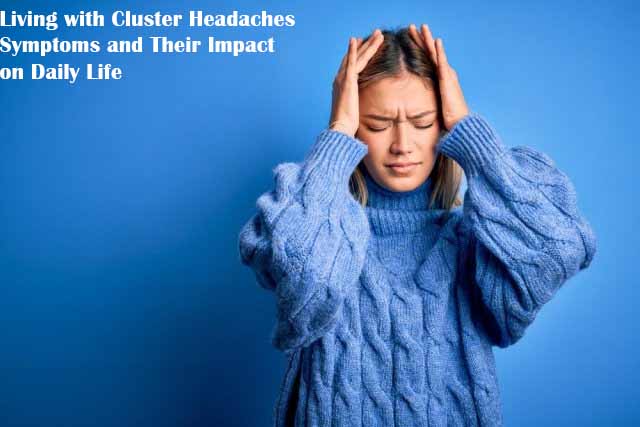Cluster or cluster headaches are usually described as pain in the temples, which is characterized by periodic attacks. According to statistics, few people experience this condition: cluster headache (CGB) is diagnosed in only 0.4% (according to other sources, up to 5%) of people worldwide.

Experts note that about 4% of patients inherit this type of pain from their next of kin in the ascending line. The disease mainly affects men aged 20-40 years, they suffer from this disease almost 5 times more often. In women, there are 2 age peaks of the condition:
- 15-20 years;
- 45-50 years old.
How Do Cluster Headaches Manifest Themselves?
Temporal pain is additionally accompanied by vegetative manifestations. Among them are the following signs:
- rhinorrhea ;
- ptosis;
- tearing;
- difficulty breathing through the nose.
Typically, patients experience episodic cluster headaches. One or more attacks appear for at least 2-3 months. After that, many go into remission, which can last for months or even years. But this is not the only scenario. Sometimes there is no remission.
During an exacerbation of cluster headaches, the use of alcoholic beverages can exacerbate the situation. There were no such cases during the remission period.
The severity of signs in the KGB is quite peculiar. Most patients have seizures frequently. Mostly appear at the same time, mostly in the morning.
The pain is usually unilateral, that is, it occurs only on one side of the head. Starting suddenly, with minor pain, KGB peaks in just a few minutes. The duration of the attack varies from half an hour to an hour.
Other cluster headache symptoms include:
- Horner’s syndrome, which is a combination of ptosis of the upper eyelid, enophthalmos, that is, retraction of the eyeball, and a decrease in the pupillary opening (miosis, or pinpoint pupil);
- redness of the skin of the face;
- restless condition, in contrast to migraine ;
- hyperhidrosis;
- conjunctival hyperemia.

Reasons for The Development of The Condition:
Today, it is not completely understood why cluster headache develops in some patients and does not appear in others. Some experts are inclined to believe that pain is a consequence of the following conditions and pathologies:
- Disruption of the hypothalamus. This part of the human brain controls the activity of the circulatory and nervous systems. If his work fails, the KGB appears.
- Abnormal development of the trigeminal nerve.
- Improper production of the hormone serotonin, which affects biorhythms.
- Damage to the SNS (sympathetic nervous system). As a result, the vessels dilate, spasm, and a cluster headache develops.
In some cases, KGB is the result of many diseases. Including – aneurysms of the carotid artery, dystonia of cerebral vessels, and orbital myositis.
Risk Factors For Developing Cluster Headaches Include:
- alcohol abuse;
- tobacco smoking;
- flight by plane over a long distance;
- weather changes;
- unstable psychological and emotional state;
- stress and prolonged depression;
- oversaturation of the body with nitrates as a result of the use of products containing this substance in quantities exceeding safe concentration levels.
Why is Cluster Headache Dangerous?
In KGB, the intensity of pain is extremely high, and is best described by the word “unbearable.” Despite the fact that the attacks themselves can last a relatively short time, the patient is exhausted by the fear of another attack. As a result, anxiety often increases, and depressive states may develop. There are cases of suicide attempts due to fear of unbearable pain.
Another danger lies in the risk of overdosing and overdosing on drugs in an attempt to get rid of the disease. It can harm other organs and systems. And it can also lead to the formation of drug dependence on potent drugs.
What examinations are prescribed for cluster headaches?
The diagnosis of “cluster headache” is based on the identification of pronounced symptoms in the patient. In the case of atypical manifestations of the condition, diagnostic studies are prescribed, such as:
- magnetic resonance imaging of the brain;
- computed tomography of the brain.
In case of exclusion of organic pathology, the specialist interrogates the patient about the nature of the pain in the temples. Confirmation of the following data allows you to correctly diagnose the condition:
- 5 or more recent seizures
- the presence of pain localized from one part of the head for 1-3 hours;
- the presence of other symptoms, such as swelling of the eyelids, drooping of the eyelids, injection of the conjunctiva;
- the frequency of occurrence of seizures up to 8 times within 24 hours.
Depending on the number of signs and their frequency of manifestation, other studies may also be prescribed. For example, duplex examination and angiography. In addition to the prescribed research methods, the patient is sent for testing:
- OAC;
- blood chemistry;
- correlogram.
What Is The Treatment?

The first line of treatment for KGB involves taking pain medication prescribed by your doctor.
Oxygen therapy allows you to get rid of acute attacks of pain. Inhalation of an oxygen mixture with water vapor (oxygen insufflation) shows positive results. To do this, the patient is put on a mask and oxygen is supplied through it. In some cases, pain may return after oxygen therapy is stopped. In such a situation, it is recommended to continue therapy until the final disappearance of the attack.
If pain medication and oxygen therapy do not help, and the symptoms only get worse, the patient needs surgical treatment. Commonly used invasive methods include:
- radiofrequency thermoregulation of the trigeminal nerve;
- triple rhizotomy;
- occipital nerve stimulation.
How can cluster headaches be prevented?
An integrated approach in the prevention of cluster headaches shows high efficiency. Key activities include:
- Compliance with the mode of activity and rest. This is especially true for teenagers.
Avoid passive and active smoking. - Exclusion of alcoholic beverages and energy drinks.
- Periodic exercise. Depending on the physique of a person, jogging, walking, swimming, and aerobics can be shown.
- Refusal of fatty, fried, and overly sweet foods. Filling the diet with vegetables, herbs, cereals, and fruits.
Cluster headache is a rare condition. But with timely detection and diagnosis of the condition, the development of complications can be avoided.
We also recommend visiting
5 Benefits of Using a Wearable Breast Pump.
Best Educational Games for 7-Year-Old Girls: Fun Games That Teach


